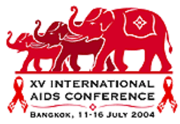 |
 |
 |
| |
PHARMACOKINETIC INTERACTIONS OF ATAZANAVIR AND SAQUINAVIR IN ARITONAVIR BOOSTED DOUBLE-PROTEASE INHIBITOR THERAPY REGIMEN: ATSAQ Cohort Study
|
| |
| |
|
|
| |
| |
 |
|
| |
| |
XV Intl AIDS Conference, Bangkok, Thailand, July 2004
Nils H. von Hentig (Institute for Clinical Pharmacology & HIV Treatment and Research Unit of the JW Goethe-University, Frankfurt) et al presented these data at Bangkok in an oral abstract.
Recently it has been demonstrated that AZV independently from RTV may act as a pharmaco-enhancer for SQV. Therefore concomitant boosting of SQV with AZV and RTV may be an option for salvage therapy. The objective of this study was to investigate potential pharmacokinetic (PK) interactions of AZV, SQV and RTV in patients.
Steady state plasma drug levels of AZV, SQV and RTV were determined in 40 HIV-1 infected adult patients, taking SQV 1000mg BID and AZV 300/RTV 100mg QD. The results were compared to PK data from 100 patients treated with SQV 1000mg/RTV 100mg BID + 2 or 3 reverse transcriptase inhibitors (RTI) (LOPSAQ study) and 50 patients treated with AZV 300/RTV 100mg BID +2 or 3 RTI.
Atazanavir (ATV), saquinavir (SQV), and ritonavir (RTV) plasma drug levels were compared between patients taking:
--ATV/RTV 300/100mg once daily (QD) + SQV 1000mg bid, n=40
or
--ATV/RTV 300/100mg QD + NRTI BID, n=50
or
--SQV/RTV 1000/100 bid + NRTI, n=100
INCLUSION
--patients treated with SQV/ATV/RTV or ATV/RTV + NRTIs who completed a24-hr PK between 03/2003 & 06/2004
--patients treated with SQV/RTV + NRTI who completed a 24-hr PK between 03/2001 & 06/2004
EXCLUSION
--patients with liver cirrhosis (Child-Pugh B or C)
--incompliant patients with incomplete documentation
--patients taking other drugs, known to influence the CYP450 3A4 pathway
BASELINE PATIENT CHARACTERISTICS
70-80% men
median CD4 count: 168-270
median HIV RNA: 3300 c/ml in ATV/RTV qd+SQV bid group; 56000 c/ml in ATV/RTV qd+NRTI; 1500 c/ml in SQV/RTV bid+NRTI.
RESULTS
Compared to the SQV/RTV + NRTI group, the RTV AUCss was significantly higher, when given as a booster of the ATV/SQV double-PI therapy regimen.
Exposure to SQV & ATV was significantly increased in the ATV/SQV/RTV group compared to each of the boosted single PI-regimen with NRTI backbone.
ATV acts as a second booster for RTV & SQV.
The resorption of RTV in presence of ATV is faster, which may lead to an earlier & more extended boosting of SQV & ATV.
No difference in the AUCss of ATV is caused by either gender or concomitant intake of TDF.
The ATV plasma exposure in this study is higher, when co-dosed with SQV in comparison to ATV/RTV + NRTI. The reasons for this need further evaluation & discussion.
PK TABLE
| Regimen | n | AUCss (ng*h/ml) | Cmin (ng/ml) | Cmax (ng/ml) | | | Median (range) | median(range) | median(range) | | ATV | 40 | 48383 (8039-105170) | 584 (104-1780) | 4625 (794-8070) | | SQV | | 25931 (8813-80600) | 384 (98-2980) | 3735 (1200-10800) | | RTV | | 8717 (2122-34407) | 20 (8-187) | 1220 (254-3200) | | ATV | 50 | 37583 (7285-19290) | 424 (55-1950) | 3295 (612-7380) | | RTV | | 8621 (1747-21942) | 46 (16-212) | 1100 (167-2680) | | SQV | 100 | 17964 (3203-52960) | 437 (68-2200) | 2805 (874-8730) | | RTV | | 6754 (2030-26235) | 200 (8-1160) | 961 (304-3300) |
ATV AUC-ss
P=.003
ATV/SQV/RTV vs ATV/RTV
ATV Cmin
(p=.005)
ATV/SQV/RTV va ATV/RTV
ATV Cmax
P=.004
SQV AUC-ss
P=.01
ATV/SQV/RTV vs SQV/RTV
SQV Cmin
P=.86 (ATV/SQV/RTV vs SQV/RTV)
SQV Cmax
P=.032
ATV/SQV/RTV vs SQV/RTV)
RTV AUC-ss
ATV/RTV/SQV vs SQV/RTV group (p=.075); 8621 ATV/RTV (P<.05 vs SQV/RTV).
|
| |
|
 |
 |
|
|